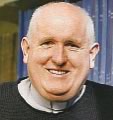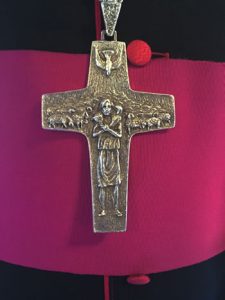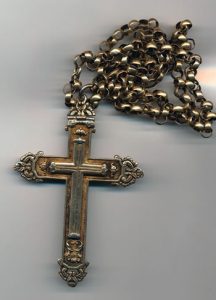Pectoral Crosses: Pompallier and Francis
A pectoral cross is a large cross worn on the centre of the chest, below the heart, suspended by a chain around the neck. They are a public proclamation of one’s Christianity, just like the small cross which some people wear on a necklace. As such they have been worn by laity and clerics on and off through history as fashion dictates. About the fourteenth century it became customary for high-ranking clerics to wear a pectoral cross and the use by laity and ordinary priests declined.
Bishops, on a formal occasion, often wear their pectoral cross over their clerical attire. In liturgy they wear it atop their alb and often over the chasuble.
As is to be expected for a symbol that has been around for such a long time, there are an enormous variety of pectoral crosses from the plain unadorned to elaborately jewelled symbols of the victorious risen Christ. While some are crucifixes as such, many are miniature icons in a cruciform frame. There are examples depicting the Virgin Mary and other saints rather than the Christ.
One photo shows the pectoral cross of Bishop Pompallier, which is a cross-shaped frame about a resurrection cross (i.e. without a corpus) surrounded by four fleurons (flower-shaped ornaments or motifs) indicating the fruitfulness of the cross of Christ.
The reason for this article on Pectoral Crosses is the request from a subscriber for a discussion of the pectoral cross of Pope Francis with its fascinating image of the Good Shepherd.
The first thing to observe is that he wore this pectoral cross as Archbishop Bergoglio well before he became Pope, that it is not particularly unusual, and not unique to him. It is a commercial product which was available from ecclesiastical shops in Rome and elsewhere. It originates from the small workshop of Giuseppe Albrizzi in Pavia, Italy. Giuseppe attributes the design to his teacher, and previous employer, the late Antonio Vedele. Vedele drew the design, which Albrizi inherited and then realized by making the cross in wax and then using that to produce the mould with which to cast the metal crosses.
Depicted on the cross is the figure of the Good Shepherd leading his flock, while carrying a lamb on his shoulders. Descending on him from above is the Holy Spirit in the form of a dove. This achieves quite a dense cluster of symbols and biblical allusions.
Firstly, there is almost a crucifix here – we have a cross shape with Christ upon it, but it is not the earthly Jesus, rather it is him under the title of Good Shepherd. This alludes to the text in the Gospel of John “I am the good shepherd; the good shepherd lays down His life for the sheep.” (John 10:11) It is not unusual to see Christ as King upon a cross but I do not recall having seen a Shepherd crucifix before.
Secondly, this is a Bishop’s cross and it shows a good shepherd leading his flock and caring for a lamb. The wearer is being asked to imitate the symbol he bears. As pastor of a diocese it is his job to lead, to care for, and to hold together the flock. It evokes the prophet Jeremiah who said “I will set shepherds over them who will care for them, and they shall fear no more, nor be dismayed, neither shall any be missing, declares the LORD.” (Jer 23:4)
Thirdly, the lamb on the shoulders reminds us of the parable of the ninety-nine sheep and the one that has gone missing- “And when he has found it, he will joyfully carry it home on his shoulders” (Luke 15:5) though the shepherd in this artwork is bringing the whole hundred home with him.
Fourthly, the presence of the dove descending connects us to another series of biblical scenes, initially the Baptism of Jesus, where “the Holy Spirit descended on him in bodily form like a dove. And a voice came from heaven: ‘You are my Son, whom I love; with you I am well pleased.’” (Luke 3:22). Then the voice connects to the Transfiguration scene: “While he was still speaking, a bright cloud covered them, and a voice from the cloud said, ‘This is my Son, whom I love; with him I am well pleased. Listen to him!’” (Matt 17:5) That command to listen in conjunction with the shepherd imagery brings us back to the Good Shepherd discourse in John’s gospel: “I have other sheep, which are not of this fold; I must bring them also, and they will hear My voice; and they will become one flock with one shepherd.” (John 10:16)
Artworks gain evocative power when they are powerfully used. By association with Pope Francis the imagery of the “shepherd cross” has gained popularity and it will henceforth always be connected with him and his teachings. One notable example of that teaching is his homily at the Chrism mass in 2015 where he exhorted the priests present to be good shepherds and declared: “If Jesus is shepherding the flock in our midst, we cannot be shepherds who are glum, plaintive or, even worse, bored. The smell of the sheep and the smile of a father…. Weary, yes, but with the joy of those who hear the Lord saying: ‘Come, O blessed of my Father’ (Matt 25:34).”



 Entries(RSS)
Entries(RSS)